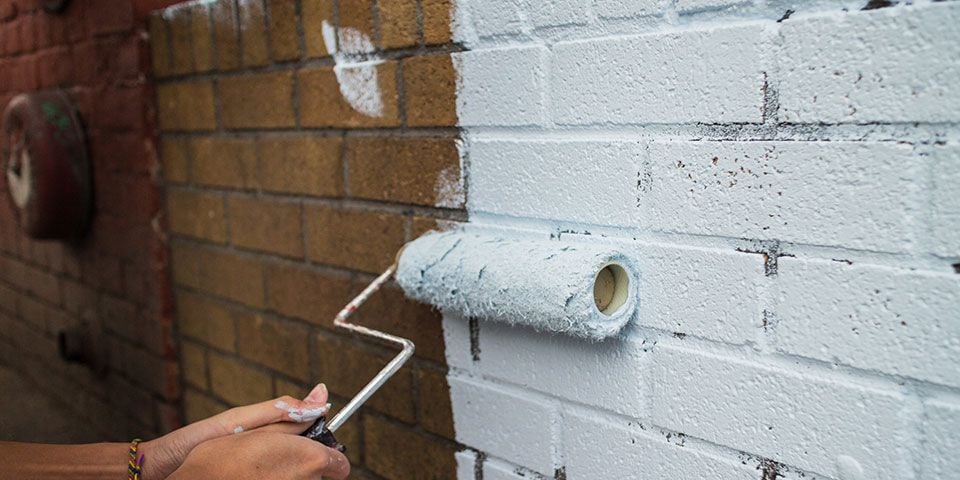Stain Brick, Whitewash Brick, or Paint Brick: Compared

So, you’re ready to update your brick home…
The color is fading and you want to refresh its curb appeal, or maybe you feel like your exposed brick wall is deflecting the light and darkening your living room. You search for a solution but are overwhelmed by the different options:
- Whitewashing brick
- Staining brick
- Painting brick
What’s the difference? Which is going to yield the result you want?
Don’t worry, that’s exactly what we’re going to discuss today. While there are some similarities in the various methods, each has a different effect on the brick and its appearance which will affect your final product.
Whitewashing Brick
Whitewashing is a technique in which a mixture of hydrated lime, salt, and water is used to mute the brick’s natural color with a finish that can range from translucent to a bright white depending on the concentration of the solution. Whitewash preserves the natural texture of the brick while bonding tenaciously to any masonry or coarse wood surface.
Some people use paint that they thin out with water to create a similar look but it does not give quite the same result.
When applying whitewash, you will need both a paintbrush and an old rag. It will be a very watery mixture so you will need the rag to wipe the excess. You’ll want to start at the top and work down so that it doesn’t drip any whitewash onto completed sections.
You can control this process by controlling the thickness of the whitewash you apply. The thicker you make it, the more you’ll have to pat and dab.
When whitewash dries, it typically looks more opaque than when it’s wet. We would recommend applying different variances of whitewash thickness on scrap bricks and letting it dry for a day or two to see how many coats you want to apply on the actual wall.
One of the great things about whitewash is that you can color it just about any color you want; there are all sorts of ways to add color with pigments and it’s fun to experiment.
And one last tip: wear gloves! Hydrated lime is very alkaline and it can cause significant irritation to your skin as you are patting, dabbing, and wringing out the whitewash-soaked cloth.
Painting Brick
Painting brick is just what you’d imagine it to be: you are painting 100% latex paint over top. But the brick doesn’t absorb paint like it does whitewash and brick stain. The paint sits on the surface of the brick and creates a noticeably-painted, thick, flat finish, which causes the brick to lose its natural look and feel.
Painting brick does require consistent maintenance. The day you paint your brick is the day that the paint starts to degrade and maintenance begins. You can expect to repaint your brick every 3-5 years, according to the Brick Industry Association. This is due to common adhesion problems associated with painting brick like efflorescence, that white salt deposit that forms on the surface of old brick. These deposits essentially sit under the paint and cause it to lift and peel.
Paint also traps moisture within the bricks rather than allowing it to breathe, which is essential for the porous material. Paint saturates the brick’s pores and prevents it from effectively releasing water and moisture. Because the moisture cannot evaporate, it stays trapped within its interior and causes the paint to blister and chip. More and more water will buildup within those cracks and cause water damage over time.
Staining Brick
Quicker and easier than painting, brick staining accentuates the natural texture of the brick rather than masking it. It absorbs into the brick rather than covering the surface like paint, so ultimately a stain acts like a dye. Preparing brick for staining is the same process as preparing it for painting: you’ll want to thoroughly clean the surface and allow it to dry fully before you start staining.
Staining works best on brick that stands in good condition.
You’ll want to start by testing the stain on an inconspicuous part of the brick. If this test does not produce a color that is desirable to you, you can darken it by adding more pigment and lighten the tone by adding water.
Once you have a color you like, spread the stain onto the brick by moving the brush in a constant direction. Or for a more uniform application, use a clean rag to wipe the stain onto the brick. This will allow it to seep in a bit more than a brush would.
Spread the stain in one thin layer, wait 24 hours, then add a second coat. And don’t forget to wear goggles and gloves.
Which Is Better?
Although you might feel like there is a clear winner between these three methods, determining the best one depends on the result that you’re looking for.
If you want something permanent and don’t feel like having the consistent task of upkeeping it, you won’t want to paint your brick. Staining or whitewashing are much more permanent options.
Do you want to maintain the natural integrity of the brick? It’s textured look and feel? Then painting it will not give you that result. It forms a thick film over top of the brick whereas staining and whitewashing seep into the brick to preserve its rough finish.
For more expert tips, inspiration, and all the bricks you could need, visit your local Batchelder & Collins or call 757-625-2506 today! We also offer fire bricks for building outdoor fire pits and the likes!
Enjoy Your Backyard All Fall Long

Now is the perfect time to take advantage of autumn’s mild days to prepare your backyard for the cold months ahead. But who’s to say you can’t still enjoy your backyard, spending time with your family, and cooking outdoors all fall long.
"*" indicates required fields


